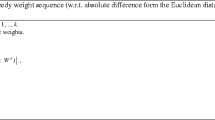Abstract
Chamfer distances on the isometric grid are considered. A new method to compute the chamfer distances based on linear optimization is presented. In the LP model the starting pixel is the Origin, that is a triangle of the grid having co-ordinates (0, 0, 0). The co-ordinates of the end pixel of the path give the right-hand side of the model. The variables are the used numbers of the elementary steps. Each type of an elementary step has a uniquely defined weight. Our operational research approach determines the optimal paths as basic feasible solutions of a linear programming problem. We give directed graphs with feasible bases as nodes and arcs with conditions on the used weights such that the simplex method of linear programming may step from one feasible basis to another feasible basis. Thus, the possible course of the simplex method can be followed and the optimal bases can easily be captured. Thus, the final result of the analysis is an O(1) checking of the feasibility and optimality conditions. The optimal bases are summarized in a theorem which is the consequence of the general theory of linear programming. The method can be applied for other grids, but it needs to be adjusted for the particular grid.




Similar content being viewed by others
References
Borgefors G (1986) Distance transformations in digital images. Comput Vis Graph Image Process 34:344–371
Borgefors G (1988) Hierarchical chamfer matching: a parametric edge matching algorithm. IEEE Trans Pattern Anal Mach Intell 10(6):849–865
Deutsch ES (1972) Thinning algorithms on rectangular, hexagonal and triangular arrays. Commun ACM 15:827–837
Dijkstra EW (1959) A note on two problems in connexion with graphs. Numerische Mathematik 1:269–271
Forchhammer S (1989) Euclidean distances from chamfer distances for limited distances. In: Proceedings of Sixth Scandinavian Conference on Image Analysis (SCIA’89), Oulu, Finland, pp 393–400
Her I (1995) Geometric transformations on the hexagonal grid. IEEE Trans Image Proc 4:1213–1221
Klette R, Rosenfeld A (2004) Digital geometry. Geometric methods for digital picture analysis. Morgan Kaufmann Publishers, San Francisco
Kovács G, Nagy B, Vizvári B (2017) Weighted distances and digital disks on the Khalimsky grid: disks with holes and islands. J Math Imaging Vis 59:2–22
Leyzorek M, Gray RS, Johnson AA, Ladew WC, Meaker SR, Petry RM, Seitz RN (1957) Investigation of model techniques. First Annual Report, 6 June 1956–1 July 1957, A Study of Model Techniques for Communication Systems, Cleveland, Ohio, Case Institute of Technology
Luczak E, Rosenfeld A (1976) Distance on a hexagonal grid. IEEE Trans Comput C-25(5):532–533
Murty KG (1995) Operations research—deterministic optimization models. Prentice-Hall, Upper Saddle River
Nacken P (1994) Chamfer metrics in mathematical morphology. J Math Imaging Vis 4:233–253
Nagy B (2003a) Distance functions based on neighbourhood sequences. Publicationes Mathematicae Debrecen 63:483–493
Nagy B (2003b) Shortest path in triangular grids with neighbourhood sequences. J Comput Inf Technol 11:111–122
Nagy B (2004) Characterization of digital circles in triangular grid. Pattern Recognit Lett 25:1231–1242
Nagy B (2007a) Digital geometry of various grids based on neighbourhood structures. In: Proceedings of 6th conference of Hungarian association for image processing and pattern recognition (KEPAF 2007), Debrecen, Hungary, pp 46–53
Nagy B (2007b) Distances with neighbourhood sequences in cubic and triangular grids. Pattern Recognit Lett 28:99–109
Nagy B (2008) Distance with generalised neighbourhood sequences in \(n\text{ D }\) and \(\infty \text{ D }\). Discrete Appl Math 156:2344–2351
Nagy B (2009) Isometric transformations of the dual of the hexagonal lattice. In: Proceedings of 6th international symposium on image and signal processing and analysis (ISPA 2009), Salzburg, Austria, pp 432–437
Nagy B (2014) Weighted distances on a triangular grid. In: Combinatorial image analysis (IWCIA 2014), LNCS 8466, pp 37–50
Nagy B (2017) Application of neighborhood sequences in communication of hexagonal networks. Discrete Appl Math 216:424–440
Prékopa A (1972) On the number of vertices of random convex polyhedra. Periodica Math Hung 2:259–282
Rosenfeld A, Pfaltz JL (1968) Distance functions on digital pictures. Pattern Recognit 1:33–61
Strand R (2009) Weighted distances based on neighborhood sequences for point-lattices. Discrete Appl Math 157:641–652
Svensson S, Borgefors G (2002) Distance transforms in 3D using four different weights. Pattern Recognit Lett 23:1407–1418
Yamashita M, Ibaraki T (1986) Distances defined by neighborhood sequences. Pattern Recognit 19:237–246
Author information
Authors and Affiliations
Corresponding author
Additional information
Publisher's Note
Springer Nature remains neutral with regard to jurisdictional claims in published maps and institutional affiliations.
Rights and permissions
About this article
Cite this article
Kovács, G., Nagy, B. & Vizvári, B. Chamfer distances on the isometric grid: a structural description of minimal distances based on linear programming approach. J Comb Optim 38, 867–886 (2019). https://doi.org/10.1007/s10878-019-00425-x
Published:
Issue Date:
DOI: https://doi.org/10.1007/s10878-019-00425-x
Keywords
- Chamfer distances
- Weighted distances
- Optimization
- Shortest paths
- Linear programming
- Digital geometry
- Non-traditional grids




